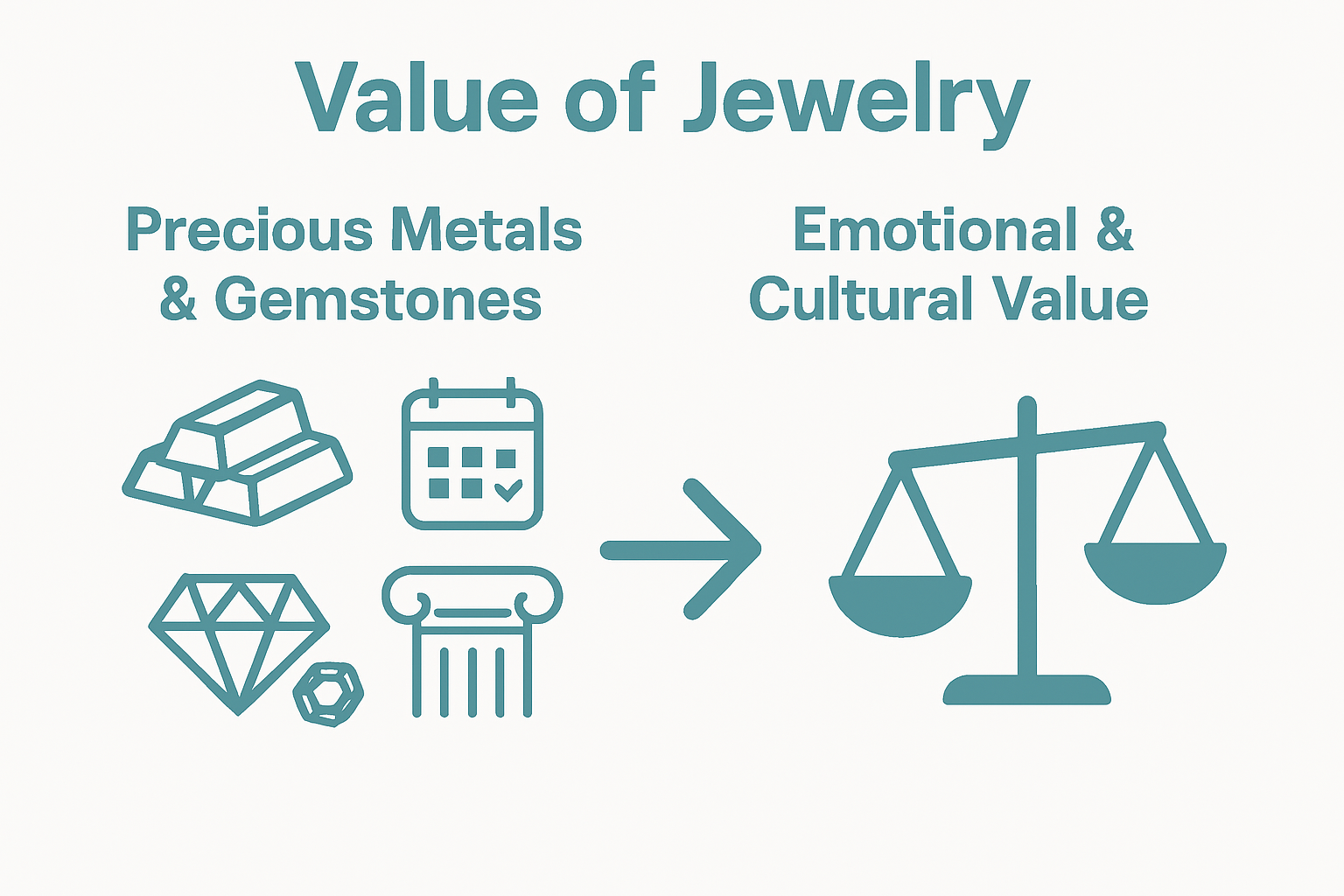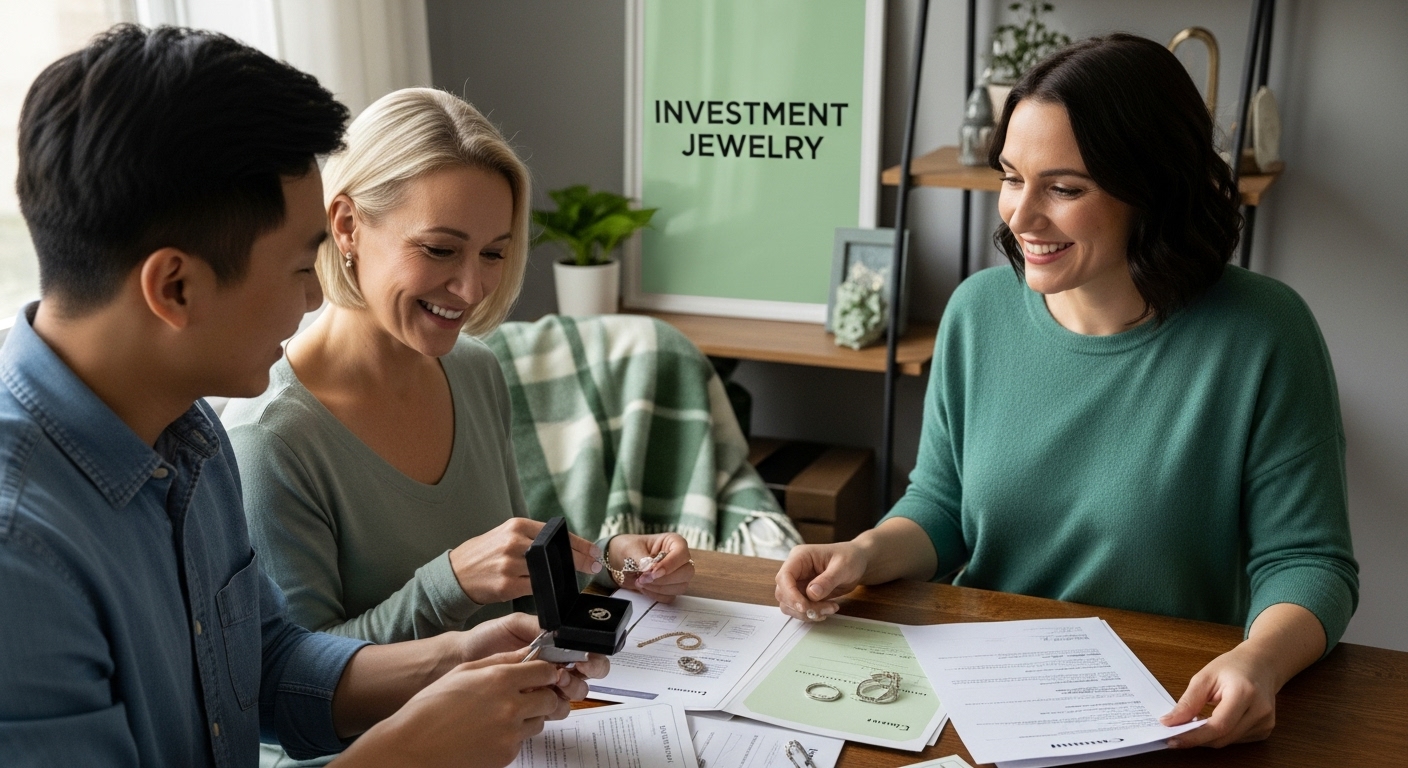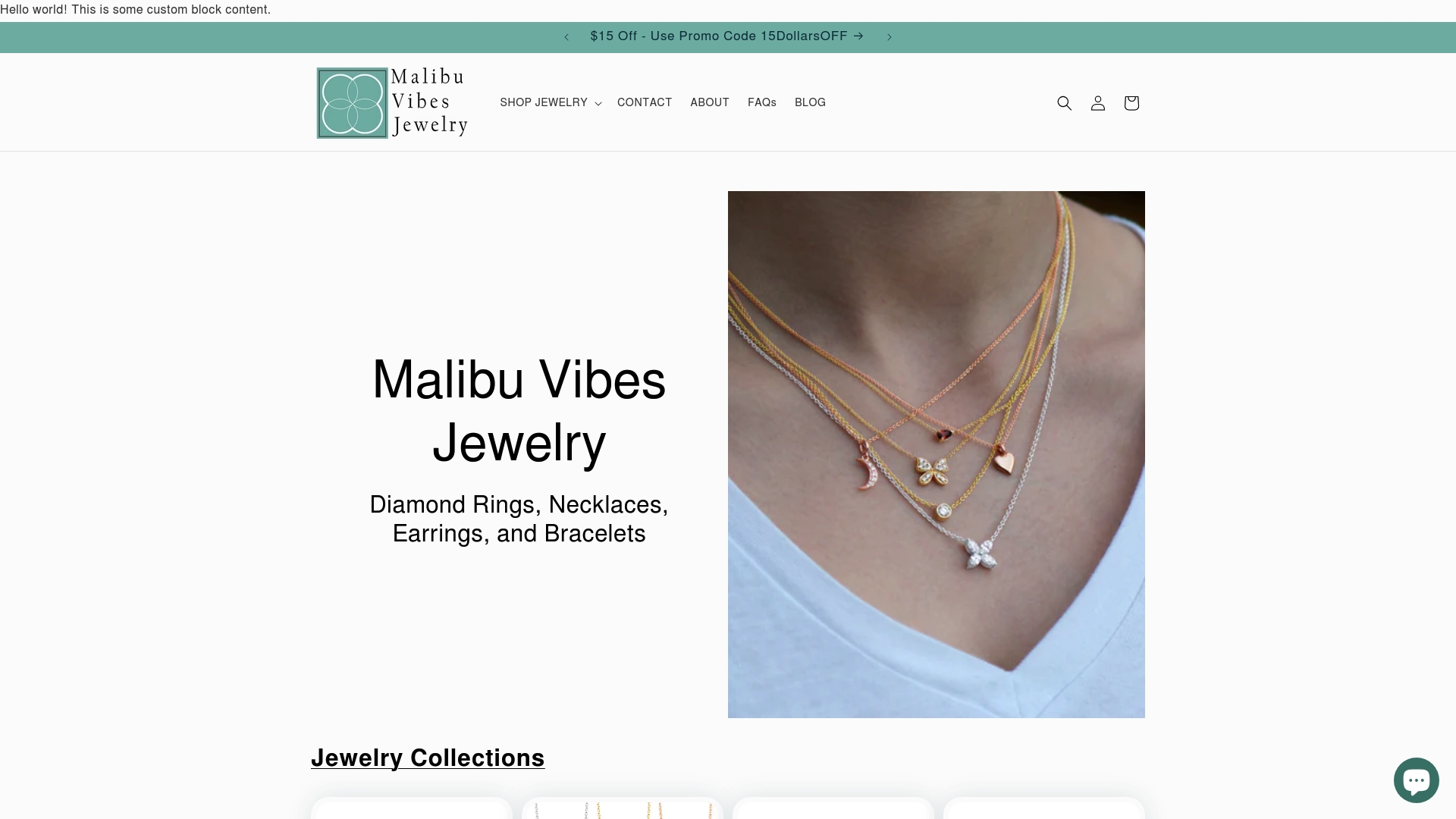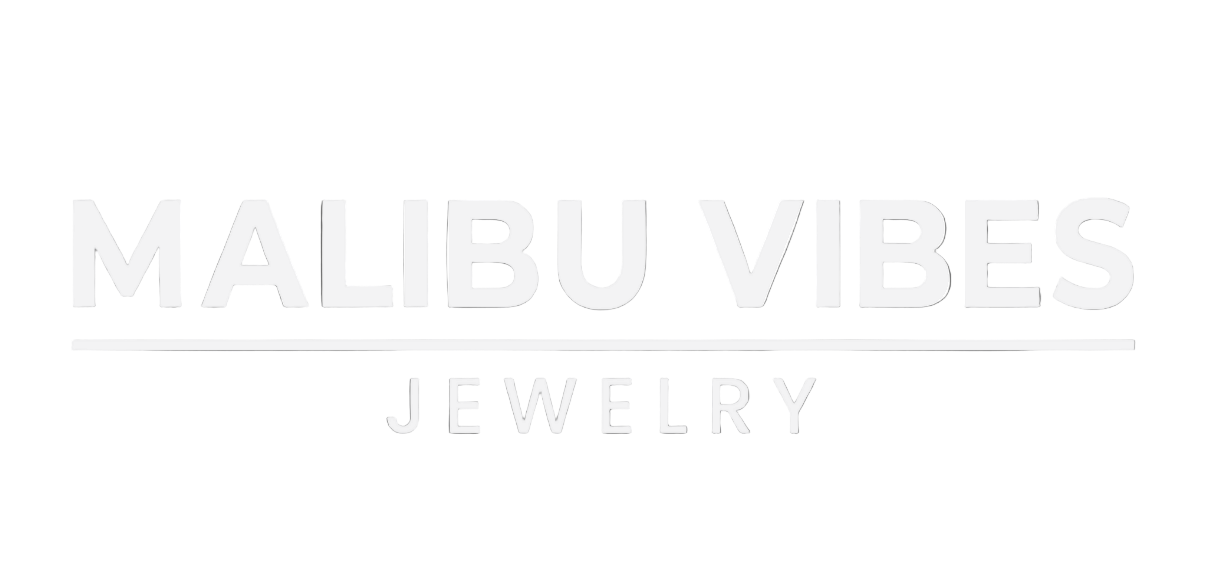Jewelry holds far more than just sparkle or status. Collectors and families are discovering that certain gemstone pieces have outperformed the stock market over the past ten years. Most people think of jewelry as a fleeting fashion or sentimental keepsake, but its true value might surprise you. Under the surface, these gleaming heirlooms can become powerful financial tools and carriers of family wealth.
Table of Contents
- What Makes Jewelry A Valuable Investment?
- The Emotional And Financial Significance Of Jewelry
- Understanding Different Types Of Investment Jewelry
- Factors Influencing Jewelry Value Over Time
- How To Assess Jewelry As A Long-Term Investment
Quick Summary
| Takeaway | Explanation |
|---|---|
| Jewelry as a Financial Asset | Jewelry’s intrinsic value comes from precious materials and potential long-term appreciation, making it an appealing investment alternative. |
| Choose High-Quality Pieces | Focus on rarity, craftsmanship, and provenance, as these factors significantly enhance a piece’s investment potential. |
| Understand Emotional Significance | Jewelry often holds personal and cultural meaning, which can elevate its value beyond mere financial metrics. |
| Professional Authentication is Key | Always seek professional certification and documentation to verify a piece’s authenticity and inherent value before investing. |
| Monitor Market Trends | Stay informed about market dynamics and collector interests to make educated investment decisions and understand potential appreciation. |
What Makes Jewelry a Valuable Investment?
Jewelry transcends mere aesthetic appeal, emerging as a strategic financial asset with unique investment characteristics. Unlike traditional investment vehicles, fine jewelry offers a compelling combination of tangible value, aesthetic pleasure, and potential long-term appreciation.
Intrinsic Material Value
The fundamental investment potential of jewelry stems from its core materials. Precious metals like gold, silver, and platinum, along with high-quality gemstones, represent inherent monetary worth. Research from the Gemological Institute of America indicates that certain gemstones and metals maintain stable value over time, making them attractive alternatives to volatile financial markets.
Key factors contributing to jewelry’s intrinsic value include:
- Rarity of materials
- Quality and purity of metals
- Gemstone characteristics like cut, clarity, and carat weight
- Historical market performance
Preservation of Wealth and Emotional Investment
Beyond monetary considerations, jewelry represents a unique form of wealth preservation that carries emotional and cultural significance. Heirloom pieces often appreciate in value, transforming personal adornments into generational financial assets. Learn more about understanding fine jewelry and its investment potential.
Investment-grade jewelry typically demonstrates several characteristics that enhance its long-term value:
- Limited production runs
- Exceptional craftsmanship
- Designs from renowned artisans
- Historical or cultural significance
Understanding jewelry as an investment requires recognizing its multifaceted nature. While not all jewelry appreciates equally, strategic selections can yield significant financial benefits. Careful research, authentication, and preservation are crucial in transforming beautiful accessories into valuable financial instruments.
The Emotional and Financial Significance of Jewelry
Jewelry represents far more than a simple accessory or financial asset. It embodies a complex intersection of personal emotion, cultural tradition, and potential economic value that transcends traditional investment paradigms.
Cultural and Personal Symbolism
Across global cultures, jewelry carries profound symbolic meaning that extends beyond monetary worth. Wedding rings, family heirlooms, and ceremonial pieces represent emotional connections, familial heritage, and personal milestones. Understanding the meaning of different gemstones can reveal deeper insights into how jewelry communicates personal narratives and emotional landscapes.
Key emotional dimensions of jewelry include:
- Commemorating significant life events
- Representing familial connections
- Expressing personal identity
- Preserving cultural traditions
Investment Beyond Monetary Value
While financial potential is important, jewelry’s true value lies in its ability to blend emotional significance with potential economic appreciation. According to research exploring jewelry investment dynamics, the most valuable pieces often transcend pure monetary considerations.
Characteristics that elevate jewelry’s intrinsic value include:
- Exceptional craftsmanship
- Historical provenance
- Unique design elements
- Emotional and cultural resonance
Ultimately, jewelry represents a nuanced form of personal and financial expression. Its value is not merely determined by market rates or material composition, but by the rich tapestry of human experience, personal meaning, and cultural significance it embodies.
 Viewing jewelry through this multifaceted lens transforms it from a simple ornamental object into a powerful medium of personal storytelling and potential financial strategy.
Viewing jewelry through this multifaceted lens transforms it from a simple ornamental object into a powerful medium of personal storytelling and potential financial strategy.
Understanding Different Types of Investment Jewelry
Investment jewelry represents a sophisticated asset class that goes beyond traditional financial instruments, offering unique opportunities for wealth preservation and potential appreciation. Understanding the nuanced landscape of investment-grade jewelry requires deep knowledge of various categories and their distinctive characteristics.
Precious Metal Jewelry
Precious metal jewelry, particularly pieces crafted from gold, silver, and platinum, forms the cornerstone of jewelry investment strategies. Learn more about investing in gold jewelry to understand the fundamental principles of metal-based investment pieces.
Key characteristics of precious metal jewelry investments include:
- High intrinsic metal value
- Global market recognition
- Relatively stable pricing
- Easy liquidity compared to other jewelry types
- Potential hedge against economic fluctuations
Gemstone and Designer Jewelry
Beyond precious metals, certain gemstone and designer jewelry pieces represent sophisticated investment opportunities. According to research exploring jewelry investment dynamics, collector-grade pieces from renowned designers or featuring rare gemstones can appreciate significantly over time.
Investment-grade gemstone and designer jewelry typically possesses:
- Limited production quantities
- Exceptional craftsmanship
- Provenance from prestigious designers or brands
- Unique or historically significant characteristics
- Potential for appreciation based on rarity
Successful jewelry investment requires comprehensive understanding of market dynamics, expert authentication, and strategic selection.
This table summarizes the major factors influencing the value of jewelry over time, making it easier to evaluate an investment piece.
| Factor | Description |
|---|---|
| Material Quality and Composition | Purity of metals, gemstone quality, rarity, and craftsmanship determine foundational value |
| Provenance and Historical Significance | Documented heritage, association with notable figures or events, limited production raises value |
| Market Trends | Price history, collector demand, economic fluctuations influence both short- and long-term value |
| Emotional and Cultural Value | Sentimental connections, cultural symbolism, and family heritage may drive additional appreciation |
| While not all jewelry appreciates equally, carefully curated pieces can serve as both aesthetic treasures and potential financial assets. Investors must approach jewelry investment with thorough research, understanding market trends, and recognizing the delicate balance between emotional value and potential financial returns. |
Below is a comparison table highlighting the two main categories of investment jewelry and their defining characteristics as discussed in the article.
| Type of Investment Jewelry | Key Characteristics | Investment Potential |
|---|---|---|
| Precious Metal Jewelry | High intrinsic metal value, stable pricing, easy liquidity, recognized globally, hedge against economic fluctuations | Typically stable, easier to liquidate, less rarity-based appreciation |
| Gemstone and Designer Jewelry | Limited production, exceptional craftsmanship, prestigious designer provenance, rarity, unique design | Greater appreciation potential due to rarity and demand but requires expertise |
Factors Influencing Jewelry Value Over Time
The appreciation and depreciation of jewelry investments involve a complex interplay of multiple dynamic factors. Understanding these nuanced elements enables investors and collectors to make more informed decisions about potential long-term value and investment strategies.
Material Quality and Composition
The fundamental determinant of jewelry value lies in its core materials and craftsmanship. Precious metals and gemstones undergo rigorous evaluation based on specific quality metrics. Explore our guide on understanding fine jewelry to gain deeper insights into material significance.
Key material evaluation factors include:
- Purity of metals (karat rating)
- Gemstone clarity and color grading
- Precision of manufacturing techniques
- Rarity of raw materials
- Structural integrity of the piece
Provenance and Historical Significance
Beyond physical composition, a piece’s historical context dramatically influences its potential value. According to research from market valuation experts, jewelry with documented heritage or connection to significant cultural moments can experience exponential appreciation.
Value-enhancing provenance characteristics include:
- Ownership by notable historical figures
- Association with specific cultural movements
- Limited edition or commemorative pieces
- Documentation of original creation
- Verifiable authenticity
Investors must recognize that jewelry valuation is not a straightforward linear progression. Market dynamics, consumer preferences, and broader economic trends continuously reshape perceived value. Successful jewelry investment requires nuanced understanding, patience, and a willingness to view these pieces as both aesthetic treasures and potential financial instruments.
How to Assess Jewelry as a Long-Term Investment
Successful jewelry investment requires strategic evaluation beyond aesthetic appeal. Investors must develop a comprehensive approach that considers multiple dimensions of potential value, combining technical expertise with market understanding.
Professional Authentication and Certification
Authenticity forms the cornerstone of jewelry investment assessment. Learn more about the differences between fine and fashion jewelry to understand the nuanced evaluation process. According to research from the Gemological Institute of America, professional certification provides critical validation of a piece’s intrinsic value.
Key authentication criteria include:
- Independent laboratory certification
- Detailed documentation of material composition
- Expert assessment of craftsmanship quality
- Verification of metal purity and gemstone characteristics
- Chain of ownership and provenance
Market Trend and Comparative Analysis
Investment potential extends beyond physical attributes, requiring sophisticated market understanding. Successful investors monitor global trends, collector interests, and economic factors that influence jewelry valuation.
Critical evaluation considerations encompass:
- Historical price performance of similar pieces
- Collector and auction market dynamics
- Emerging design and material preferences
- Geopolitical factors affecting precious metal prices
- Long-term investment horizon expectations
Jewelry investment demands patience, expertise, and a holistic perspective. While not every piece will appreciate significantly, strategic selection and comprehensive assessment can transform beautiful artifacts into meaningful financial assets. Investors must approach jewelry not merely as decorative objects, but as complex investment vehicles requiring nuanced understanding and continuous research.

Transform Knowledge Into Value With Malibu Vibes Jewelry
You have learned that building wealth with jewelry is about more than just owning something beautiful. Finding pieces that offer both emotional and financial rewards takes research and careful selection, as the article explains. The challenge is identifying genuine investment-grade jewelry that stands out for its craftsmanship, material quality, and lasting value.
If you are ready to put these insights to work, explore our Solid Gold Necklaces collection for pieces crafted to maintain value and style across generations.

Malibu Vibes Jewelry brings you handcrafted fine jewelry made from pure gold, sterling silver, and genuine gemstones. Each creation is made in Los Angeles by master artisans, so you get both investment peace of mind and a sense of belonging that only true luxury offers. Begin investing in your future today. Visit Malibu Vibes Jewelry to discover curated collections designed for lasting impact.
Frequently Asked Questions
What are the key factors that determine the value of investment jewelry?
The value of investment jewelry is determined by factors such as material quality, intrinsic metal value, gemstone characteristics, craftsmanship, and historical significance. Precious metals and high-quality gemstones typically appreciate more significantly over time.
How can I assess if a piece of jewelry is a good long-term investment?
To assess jewelry as a long-term investment, consider professional authentication and certification, evaluate market trends, and conduct comparative analyses of similar pieces. It’s essential to understand the piece’s material quality and historical provenance.
What types of jewelry are considered investment-grade?
Investment-grade jewelry usually includes pieces made from precious metals like gold, silver, and platinum, as well as designer jewelry and those featuring rare gemstones. Limited production runs and exceptional craftsmanship enhance their investment potential.
How does emotional value influence the investment potential of jewelry?
Emotional value can significantly influence investment potential since pieces like heirlooms or those commemorating personal milestones may appreciate over time due to their sentimental significance. This emotional connection often intertwines with financial value in the jewelry market.
Recommended
- Understanding Why Invest in Gold Jewelry: A Comprehensive Guide – Malibu Vibes Jewelry
- What is Fine Jewelry? Understanding Luxury and Craftsmanship – Malibu Vibes Jewelry
- What is Fashion Jewelry? Understanding Its Essence and Appeal – Malibu Vibes Jewelry
- What is Statement Jewelry: Understanding Its Impact and Style – Malibu Vibes Jewelry



